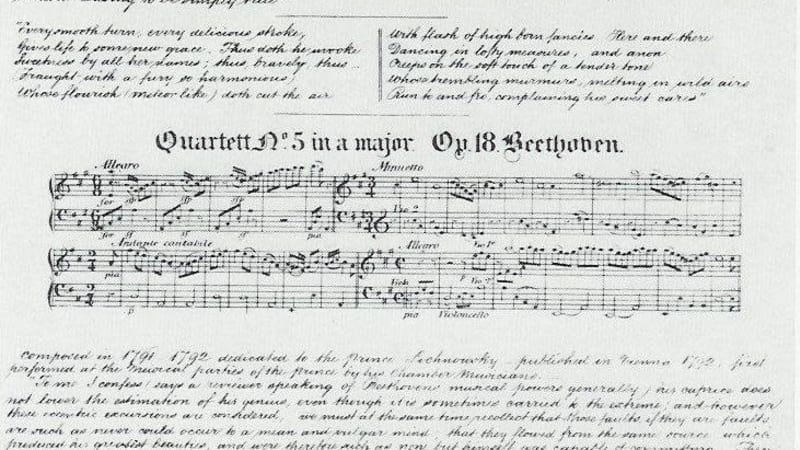The Beginning of the Beethoven Quartet Cycle
February 4, 2020
CMS presents its sixth Beethoven quartet cycle this season and this cycle is now performed many times each season all over the world. But Beethoven quartet cycles didn’t start immediately after the composer’s death. For many reasons, it was years before the cycle began to be performed regularly (and decades more before the Grosse Fuge was included). The performing landscape was very different in the early 19th century: concerts often included at least some lighter fare and audiences weren’t obsessed with experiencing complete works—let alone cycles—the way we are today. Also, many composers before Beethoven had larger oeuvres—Haydn wrote 68 quartets (compared to Beethoven’s 16) and Mozart’s complete string quartets include a lot of juvenilia. But perhaps most of all, Beethoven’s late quartets took a long time to gain widespread acceptance.
The first Beethoven quartet cycle took place in London, a city the composer never visited, in 1845, 18 years after his death. It was initiated by an enthusiastic amateur musician and influential tastemaker Thomas Massa Alsager. Though not a professional musician, Alsager started as music critic for the Times, moved to the financial pages, and eventually bought himself into part ownership of the paper. In 1830 he founded The Queen Square Select Society (under which he presented concerts at his residence in Queen Square). He’s most famous as a great lover and promoter of Beethoven’s music. On Christmas Eve 1832 he hosted the English premiere of Beethoven’s Missa Solemnis at his home. He also had extensive communication with Mendelssohn, and Mendelssohn performed at his home while visiting London.
In 1845, Alsager established the Beethoven Quartet Society, which endeavored to present “the most perfect performance possible of the Quartetts of Beethoven.” After a series of introductory concerts in February, March, and early April 1845 of Beethoven’s string quartets and piano sonatas, the cycle began on April 21. Each program included early, middle, and late quartets:
April 21: Op. 18/1, Op. 59/3, Op. 127
May 5: Op. 18/3, Op. 59/1, Op. 131
May 19: Op. 18/4, Op. 74, Op. 132
June 2: Op. 18/2, Op. 18/6, Op. 95, Op. 135
June 16: Op. 18/5, Op. 59/2, Op. 130
A notable omission was the Grosse Fuge, the original final movement to Op. 130 that was so difficult and incomprehensible that Beethoven’s publisher convinced him to substitute an easier finale and publish the Fuge separately. The Beethoven Quartet Society didn’t perform the Grosse Fuge, either as the last movement of Op. 130 or on its own. In fact, the Grosse Fuge was very rarely performed until the 20th century because of how strange it was.
The rest of Beethoven’s late quartets were also met with confusion and even decades after his death they weren’t yet universally admired or understood. Alsager worked to change that. A review of his cycle explained, “[Alsager’s] efforts have convinced amateurs that the Posthumous Quartets are not the ravings of a shattered intellect, but the inspirations of a mighty genius in the vigor of its prime.”
The cycle was repeated every year until 1851 with a break in 1849, so six times total. The goal was to keep the same performers for each cycle, but a few substitutions occurred. In a particularly modern touch, there was no fixed first violinist—the two violinists alternated first and second parts. The influential violinist Joseph Joachim, then a teenager, participated beginning in 1848. There were elaborate printed programs with notes written by the violist Henry Hill, each of which was titled HONOR TO BEETHOVEN, and the audience was encouraged to bring scores. Composer Hector Berlioz attended and raved about it.

It’s unclear why the Beethoven Quartet Society disbanded in 1851 but even in six years, it had seen many changes. Alsager died in fall 1846. There were numerous personnel changes among the artists and management. Some years the quartets of Beethoven were interspersed with some by Mozart and Haydn (headlined “GRATITUDE TO HAYDN, The Benefactor and Father”). It wasn’t until much later that Beethoven quartet cycles became widespread and Alsager in London deserves credit as the first to present the quartets as one cohesive experience.
See the Danish String Quartet perform Beethoven's full String Quartet Cycle throughout CMS's Winter Festival, February 7-18 at Alice Tully Hall.
BUY TICKETS
Article by Laura Keller, Editorial Manager.